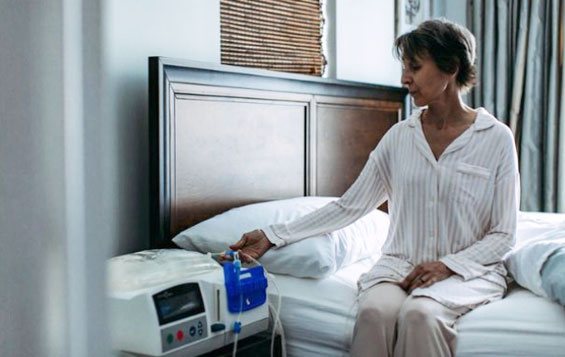
Peritoneal dialysis (PD) is a dialysis treatment option that uses your own abdomen lining to naturally filter waste from your blood. While PD does not require a needle for each treatment, patients receive a cleansing solution through a catheter and allows waste products to pass and filter through your bloodstream and removed naturally.
The PD treatment is usually done at home in multiple sessions a day or while you sleep and may require fewer food restrictions and less medication.
For PD, you will need minor surgery to have the catheter placed in your abdomen and will have to keep the area clean to avoid infections. The PD option is not for everyone as it may require some lifestyle adaptations and is not ideal for you if you do a lot of bending for your work or at home.
With PD, you will have equipment at home to set up, manage and maintain including: a catheter connected to a tubing set, an IV pole, dialysate fluid, hand soap and sanitizer and a heating pad – all of which will require a clean place for storage and handling.
Each PD session lasts about 2 hours and is done every night for approximately 9 hours while you sleep.
If PD is an option your kidney doctor recommends, your Central Florida Kidney Center care team will be available to support your home care while you continue to enjoy your life and daily activities.
This type of self-dialysis is done seven days at your home with four to five self-administered procedures each day without the use of a machine. CAPD works using an “exchange” or sessions following a few basic steps that are taught to you before you begin treatment. In between sessions, you are not connected to tubing or bags and are free to enjoy your daily activities while the dialysis takes place inside of your abdomen.
For CAPD, you will need minor surgery to have the catheter placed in your abdomen and will have to keep the area clean to avoid infections. The CAPD option is not for everyone as it may require some lifestyle adaptations and is not ideal for you if you do a lot of bending for your work or at home.
With CAPD, you will have equipment at home to set up, manage and maintain including: a catheter connected to a tubing set, an IV pole, dialysate fluid, hand soap and sanitizer and a heating pad – all of which will require a clean place for storage and handling.
Each CAPD session lasts about 2-3 hours and is done every four to five hours. Your last evening exchange remains or “dwells” inside your abdomen overnight while you are sleeping.
If CAPD is an option your kidney doctor recommends, your Central Florida Kidney Center care team will be available to support your home care while you continue to enjoy your life and daily activities.
Automated Peritoneal Dialysis (APD) is typically done in your home with treatments more frequent than in-center dialysis. APD helps removed waste and toxins out of your blood without build-up between treatments and often leaves you with more energy and more time to go about your day.
APD is a daily dialysis treatment during your sleep with the dialysis fluids cleaning your blood throughout the night. You will receive one-on-one training by a qualified nurse to give you the skills you need to perform the treatment, usually taking between one to several weeks depending on your condition and schedule.
You must be very careful to keep your APD catheter site and tubing clean and free from contact with bacteria to avoid illness. A healthy lifestyle will contribute to better results, with smart diet and nutrition habits and exercise approved by your doctor.